Rochester: Difference between revisions
m clean up, typos fixed: However → However, |
|||
| Line 132: | Line 132: | ||
* [http://www.glentour.freeuk.com/rochester_sweeps_festival.htm Photographs of the Rochester Sweeps Festival] | * [http://www.glentour.freeuk.com/rochester_sweeps_festival.htm Photographs of the Rochester Sweeps Festival] | ||
* [http://video.google.com/videoplay?docid=6380511021213931299 Google video of Morris Dancers] at Sweeps Festival Rochester 1997 | * [http://video.google.com/videoplay?docid=6380511021213931299 Google video of Morris Dancers] at Sweeps Festival Rochester 1997 | ||
{{Cities in the United Kingdom}} | |||
Revision as of 10:57, 30 March 2016
| Rochester | |
| Kent | |
|---|---|
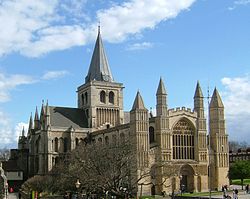 Rochester Cathedral, from the Castle Gardens | |
| Location | |
| Grid reference: | TQ739684 |
| Location: | 51°23’18"N, -0°29’54"E |
| Data | |
| Population: | 27,000 (2001) |
| Post town: | Rochester |
| Postcode: | ME1, ME2 |
| Dialling code: | 01634 |
| Local Government | |
| Council: | Medway |
| Parliamentary constituency: |
Rochester & Strood |
Rochester is a cathedral city in Kent. It has from ancient times long borne the status of a city, though this status was attached as property to a council abolished in the 1990s and the successor body failed to request that Her Majesty preserve it.
Rochester is at the lowest bridging point of the River Medway about 30 miles from London. The city is marked by two grand edifices; Rochester Cathedral and Rochester Castle. A great deal of history is found in these streets; Romans, Anglo-Saxon, Mediæval and modern. In 1215 was an epic siege which reshaped the castle.[1] Rochester, together with neighbouring Chatham, Gillingham, Strood and a number of outlying villages have grown together to make a single conurbation standing across the Medway.
The city
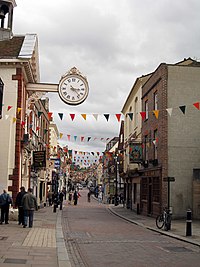
The city centre is a beautiful High Street of fine historical buildings. The Castle rises above the High Street on the river at the west, while further down is the Cathedral. Many other important historic buildings are found around the city, the most prominent being the Guildhall, the Corn Exchange, Restoration House and Eastgate House. Many of the buildings in the city centre date from the 18th century or as early as the 14th century.
Watling Street passes through the city, and to the south the River Medway is bridged here by the M2 motorway.
Parishes
There are three historic parishes within the city of Rochester; St Margaret's, St Nicholas' and the Cathedral.[2]
Name of the city
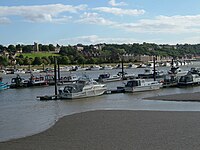
The Romano-British name for Rochester was Durobrivae, a name known elsewhere too in Britannia. Durobrivae is commonly translated as 'stronghold by the bridge' or 'stronghold by the bridges'.[3] This could have been a Belgic Settlement or oppidum, but there was no bridge in AD 43.[4] It was also known as Durobrovum and Durobrivis, which could be a Latinisation of the British word 'Dourbruf' meaning swiftstream.[5]
The ancestral English called the town Hrofeceaster, which Bede says means “Hrof's fort”, though more recent scholarship suggests that the name is derived from the native British name cognate with Durobrivae.
The Bishop of Rochester signs as Roffen, short for 'Roffensis; a Latinised version of Hrofeceaster.
History
Pre Roman
Evidence of Neolithic settlement nearby at Kit's Coty House. Belgic remains were found in 1961 by R E Chaplin under the Roman levels. Coin moulds suggest that this was a centre of some importance.
By the opening of the first century, Rochester was one of the two oppida of the Cantiaci tribe (the other being their capital, Canterbury). It was the western administrative centre of the Cantiaci kingdom.
Romans
In AD 43 the Romans arrived and called the settlement Durobrivae, which one theory derives from British words for 'fortified town by a bridge', but there is no evidence of a bridge here when the Romans arrived. The Roman settlement provides us with the present High Street and Northgate/Boley Hill.[4] A bridge was built. There is evidence that the Romans bridged the river at the same point as the present bridge. They constructed a substantial causeway, 14 feet wide, over the marshy ground on the Strood Side of the river, from the river to the present day Angel Corner.[4]
In around 190, systematic earthen fortifications were established and in the 220s these were replaced by stone, which are still extant. Two hundred years later, the Romans had left Britain.
No evidence has been found of an early Roman fort at Durobrivae. The street pattern suggest that it was a line of shops and houses built alongside a road, and systematic fortification did not take place until after AD 175.[4]
Anglo-Saxon period
The departure of the Romans left Kent open to the seaborne Germanic tribes. Tradition states that Rochester was continuously occupied, first by the Britons until they were superseded by Jutes from Jutland or Saxons. The English legend recorded in Bede and in the Anglo-Saxon Chronicle states that Jutes under two brothers, Hengist and Horsa, landed at Ebbsfleet, Thanet in 449, and defeated the Britons at Aylesford, establishing a Jutish Kingdom of Kent.
In 597, Augustine landed to convert the English to Christianity, which was swiftly accepted by King Æthelberht of Kent. In 600, the King made a code of about 90 laws dealing with criminal acts, which were copied in twelfth century in the Textus Roffensis (Rochester Text). In 604, Augustine sent Justus to found a cathedral at Rochester. He built it 42 feet high and 28 feet wide; the line of the apse is marked in the present cathedral. This was the second bishopric founded amongst the English, after Canterbury. In the same year, The King's School was founded. In 676, Rochester was sacked by Æthelred of Mercia.
In 842, Vikings sacked the town. In 877, King Alfred of Wessex ordered the building of ships to fight the Danes, which could be the start of military shipbuilding on the Medway. In 884 though the town was again besieged by Danes again. In 930 Rochester received the right to mint coins, and in 960 a wooden bridge was built across the Medway.[6]
Normans
After the Norman Conquest the English bishop Siward remained until 1076 when Gundulf, a Norman monk, was consecrated and in 1080, Gundulf began to built the new cathedral, on the site between the Roman wall and Watling Street, over the previous cathedral. Rochester Cathedral is one of England's smaller cathedrals, yet it demonstrates all styles of Romanesque and Gothic architecture.[6]
In 1087 Gundulf began work too on the castle; its curtain wall follows Roman walls, and its keep is 113 feet high, 70 feet × 70 feet in breadth. The Norman cathedral was complete.d in 1130.
Middle Ages
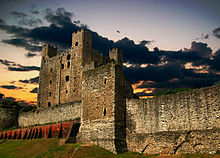
In 1215 the castle was besieged by King John; it fell on 30 November. More peacefully, in 1227 the Cathedral quire was completed. In 1264, the city was attacked by Simon de Montfort.
The central tower of the Cathedral was raised in 1343. In 1376 the Plague reached Rochester.
In 1461 the first mayor elected and in 1470 the great window at the cathedral was built.
Tudor and Stuart days
In 1535 the Bishop, John Fisher, was appointed a cardinal and executed by Henry VIII as he refused to sanction the King's divorce from Catherine of Aragon. From 1547 to 1550, Nicholas Ridley served as Bishop. In 1554 in Oxford he was martyred by Queen Mary for upholding Protestantism.
In 1559: Upnor Castle, an estuarine water castle, was built at Rochester to protect Chatham Dockyard.
On 20 May 1660, Sir Francis Clarke entertained King Charles II on the eve of his restoration to the throne. Following this, his home in Crow Lane became known as Restoration House. It was used as the basis of Satis House in Great Expectations, by Charles Dickens. On 11 June 1667 less happily, the Dutch made a naval raid on the Medway; de Ruijter broke through the chain at Upnor and sailed to Rochester Bridge capturing and firing the English fleet.[7] Trophies from the raid are in the Rijksmuseum, Amsterdam.
In 1687 the Guildhall was built; the ceiling being given by Sir Cloudesley Shovell.[6] In December the next year, King James II spent his last night as king at a house in the High Street before fleeing to France, a house which became known as Abdication House.
Georgian and Victorian times
In 1701, Sir Joseph Williamson's Mathematical School, a boys' grammar school, was founded.
In 1850 Thomas Aveling bought a small millwrighting shop in Edwards yard to produce and repair agricultural plant.[6] Aveling & Porter, then in Strood, was to become the largest manufacturer of agricultural machines and steam rollers in the country. Of the 12,700 steam engines which they made, no fewer than 8,600 of them were steam rollers.[6][8]
Military history
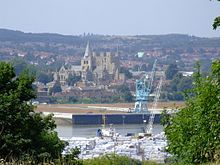
Rochester has for centuries been of great strategic importance through its position near the confluence of the Thames and the Medway. Its castle was built to guard the river crossing and the Royal Dockyard at Chatham were keys to the Royal Navy's long period of supremacy. The city, as part of Medway, is surrounded by two circles of fortresses; the inner line of forts built during the Napoleonic wars are; Fort Clarence, Fort Pitt, Fort Amherst and Fort Gillingham. The outer line of "Palmerston" forts was built during 1860s in light of the Royal Commission on the Defence of the United Kingdom report, these consisted of Fort Borstal, Fort Bridgewood, Fort Luton, and Twydall Redoubts, with 2 forts on islands in the Medway; Fort Hoo and Fort Darnet.
During the First World War the Short Brothers' aircraft company manufactured the first plane to launch a torpedo, the Short Admiralty Type 184, and during the Second World War manufactured the first four-engined bomber, the Stirling, and flying boats at its seaplane factory on the River Medway not far from Rochester Castle.
The decline in naval power and in shipbuilding in general led to the government abandoning the shipyard at Chatham in 1984, and the subsequent demise of much of the marine industry. Rochester and its neighbouring communities were hit hard by this and have experienced a painful adjustment to a post-industrial economy, with much social deprivation and unemployment resulting. On the closure of Chatham Dockyard the area saw an unprecedented surge in unemployment to 15.9%. This dropped to 3.5% in 2004.
City status
Rochester obtained city status in 1211, a status which became the personal property of the city corporation and carried through to the late twentieth century. However, due to an administrative error when the District of Rochester was absorbed by the Medway unitary authority, it technically lost its city status.[9] Subsequently, the Medway unitary authority applied unsuccessfully in 2000, 2002 and 2012 for city status for the whole district rather than for Rochester.[10] The City of Rochester Society has argued that the application for city status should be under the name of "Rochester-upon-Medway" rather than "Medway", as city status should be given to places rather than mere government districts.[11]
Culture
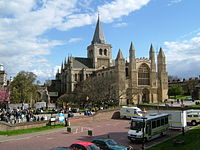
Dickens
The city was for many years the favourite of Charles Dickens who lived nearby at Gads Hill Place, Higham, and who based many of his novels in the area. Descriptions of the city appear in Pickwick Papers , Great Expectations and lightly fictionalised as Cloisterham in The Mystery of Edwin Drood. Restoration house located on Crow Lane was the house on which Charles Dickens based Miss Havisham's (from Great Expectations) house, Satis House. This link is celebrated in Rochester's Dickens Festival each June in the Summer Dickens Festival[12] and December with the Dickensian Christmas Festival.[12] The 16th century red-brick Eastgate House once housed the city's museum.
In the 1980s the museum was moved further west to the Guildhall so that Eastgate House could become the Charles Dickens Centre. In the same decade the High Street was redecorated with Victorian-style street lights and hanging flower baskets to give it a more welcoming atmosphere.
The Dickens Centre was ultimately unprofitable and shut in November 2004. Medway Council's Cabinet agreed proposals for the restoration and development of Eastgate House as a major cultural and tourist facility, and for the project to be recognised as a key cultural regeneration project on 7 November 2006.
Rochester Sweeps Festival
Since 1980 the city has seen the revival of the historic Rochester Jack-in-the-Green May Day dancing chimney sweeps tradition, which died out in the early 1900s. Whilst not unique to Rochester, (similar sweeps gatherings were held right across southern England, notably in Bristol, Deptford, Whitstable and Hastings), the Rochester revival was directly inspired by Dicken's description of the celebration in Sketches by Boz.
It has since grown from a small gathering of local Morris dance sides, to one of the largest in the world.
The current festival begins with the awakening of the Jack-in-the-Green ceremony,[13] atop Blue Bell Hill at sunrise on May 1.[14] and continues in Rochester High Street over the May Bank Holiday weekend.
Library
A new library was built alongside the Adult Education Centre, Eastgate. This enabled the registry office to move from Maidstone Road, Chatham to the Corn Exchange in Rochester High Street (where the library was housed). As mentioned in a report presented to Medway Council's community services overview and scrutiny committee on 28 March 2006, the new library opened in late summer (2006).[15]
Newspapers
Local newspapers for Rochester include The News, the Medway Messenger and yourmedway.
Radio
The local radio station for Rochester is KMFM Medway, owned by the KM Group. The area can also receive the county-wide stations BBC Radio Kent, Heart and Gold, as well as many radio stations broadcast from beyond Kent.
References
- ↑ "English Heritage Rochester Castle". English-heritage.org.uk. http://www.english-heritage.org.uk/server/show/nav.14818. Retrieved 2010-09-01.
- ↑ C Humpherey-Smith, The Phillimore Atlas and Index of Parish Registers
- ↑ The Place names of Kent. Judith Glover.1976 Batsford. 1982 Meresborough Books. ISBN 0905270 614
- ↑ 4.0 4.1 4.2 4.3 Rochester, The evolution of the City. Ronald Marsh. 1974 p&p Medway Borough Council.
- ↑ Kelly's Directory of Rochester 1951.
- ↑ 6.0 6.1 6.2 6.3 6.4 Rochester, The past 2000 years, Published Privately City of Rochester Society 1999.
- ↑ *The Dutch Raid, published by the City of Rochester Society 1998.
- ↑ *Discovering Traction Engines, - Harold Bonnett - Shire Publications (1975) - ISBN 0-85263-318-1
- ↑ Rochester loses City status
- ↑ Medway applies for City status
- ↑ Medway Messenger article, October 2010
- ↑ 12.0 12.1 Historic uk - heritage of britain accommodation guide (2010-06-06). "Destinations UK - Rochester, Kent, England". Historic-uk.com. http://www.historic-uk.com/DestinationsUK/Rochester.htm. Retrieved 2010-09-01.
- ↑ "H2G2". Bbc.co.uk. 2002-04-09. http://www.bbc.co.uk/dna/h2g2/pda/A707861. Retrieved 2010-09-01.
- ↑ *City of Rochester upon Medway Visitors Guide 1996.
- ↑ http://www.medway.gov.uk/ocs20060328r-11.pdf
Outside links
| ("Wikimedia Commons" has material about Kent Rochester) |
- Medway Council Official Site
- Archive Images
- The Medway Portal
- Rochester Airport and British Aviation
- Photographs of the Rochester Sweeps Festival
- Google video of Morris Dancers at Sweeps Festival Rochester 1997
| Cities in the United Kingdom |
|---|
|
Aberdeen • Armagh • Bangor (Caernarfonshire) • Bangor (County Down) • Bath • Belfast • Birmingham • Bradford • Brighton and Hove • Bristol • Cambridge • Canterbury • Cardiff • Carlisle • Chelmsford • Chester • Chichester • Colchester • Coventry • Derby • Doncaster • Dundee • Dunfermline • Durham • Ely • Edinburgh • Exeter • Glasgow • Gloucester • Hereford • Inverness • Kingston upon Hull • Lancaster • Leeds • Leicester • Lichfield • Lincoln • Lisburn • Liverpool • City of London • Londonderry • Manchester • Milton Keynes • Newcastle upon Tyne • Newport • Newry • Norwich • Nottingham • Oxford • Perth • Peterborough • Plymouth • Portsmouth • Preston • Ripon • Rochester • Salford • Salisbury • Sheffield • Southampton • St Albans • St Asaph • St David's • Southend-on-Sea • Stirling • Stoke-on-Trent • Sunderland • Swansea • Truro • Wakefield • Wells • Westminster • Winchester • Wolverhampton • Worcester • Wrexham • York |
